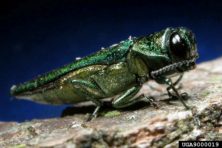Door to Nature: Ash Trees and the Emerald Ash Borer
- Share
- Tweet
- Pin
- Share
It was during the last Sturgeon Bay Christmas bird count when I noticed that several trees in the Logan Creek wetland along Sunny Slope Road had much of their bark missing. They appeared to be infected with the emerald ash borer, an aggressive insect from Asia.
The dreaded invasion was first seen in 2002 near Detroit, Mich. The insects probably entered our country in wood packing material on cargo ships from Asia. The infestation has been carefully tracked during the last 16 years, and now we know that it has affected ash trees in 35 states plus five Canadian provinces. Mississippi and Florida are the only two states east of the Great Plains that have not reported the disease. Maine has seen only a few areas with signs of infection – in the extreme northern part of the state at the Canadian border.

The dark, shiny green adult beetles are about one-half inch long. They are referred to as buprestid metallic wood-boring beetles or jewel beetles, native to northeast Asia. This family of beetles includes many larger and more spectacularly colored jewel beetles, some of which are valued by insect collectors. Most are shorter than an inch in length, but some are more than three inches long. People in India, Japan and Thailand use them in creating jewelry and for decoration.
Adult emerald ash borer beetles lay eggs in a crevice in the bark of any ash tree, and the larvae leave a D-shaped exit hole when they emerge in spring. One good thing about our recent polar vortex is that these creatures cannot withstand prolonged cold weather. Temperatures of 20 degrees below zero or colder can kill up to 80 percent of the beetles.
Woodpeckers like to eat the emerald ash borer larvae just under the bark and will strip a tree in search of that food. Thus, the ash trees we saw had become feeding stations for the local birds, and I have seen a little damage in my woods, too. The increase in emerald ash borers may be why the woodpecker population has also increased quite a bit the past few years.
Some species of jewel beetles are attracted to recently burned wood as a place to lay their eggs. These insects can sense pine smoke from up to 50 miles away and can see infrared light, which helps them home in on a forest fire.
Ash trees are a valuable source of wood for the sports industry. The white ash is used in making baseball bats, tennis racquets, hockey sticks, skis, oars and pool cues. It is also valued in the production of tool handles, paneling and veneers and in cabinet work. The wood is hard, tough and strong, and it has excellent bending qualities and wears smoothly.

White ash is considerably more valuable than the green ash and has a more limited range. It normally grows throughout most of the eastern United States and southeast Canada and extends west from eastern and southern Wisconsin through much of southern Iowa and Missouri and on to eastern Oklahoma and Texas. The southeast Atlantic coast and the Gulf of Mexico are devoid of this species except for certain parts of north-central Florida.
My late husband, Roy, used some of our own white ash trees to make picture frames. A friend helped him harvest the trees, and another cut them into boards and planed them. The grain of the wood is very striking and takes stain and varnish nicely.
Ash trees are in the olive family, which also includes some old favorites such as lilacs, forsythias, privets and jasmine plants. Many have fragrant flowers with four petals, and the predominant color of the flowers is white. White ash and the green ash both grow in my woods. They are usually the last to leaf out in spring and the first to change color and drop their leaves in fall.
They do not announce their presence as a stately, tall elm tree does. In fact, they are often in a mixed-hardwood forest and blend in with the other deciduous trees. The black ash most often grows in swamps and wetlands. Lateral twigs of the black ash extend outward more horizontally than its cousin, the white ash, whose twigs curve more upward.
Like the maple, it has opposite branches and twigs. However, unlike maples, which have single or simple leaves, ash leaves are compound, with opposite leaflets except for the one at the end. Their winter twigs and branches reach up to the sky, forming small crosses at their tips.
Ash trees – like beeches, maples, birches and basswoods – tend to favor deep loam soil, and they occur as either male or female: that is, they are dioecious. Most other trees are said to be perfect, meaning they have both male and female flowers on the same tree.
Being in the olive family, the ash tree is a great wood for burning green in my old-fashioned, cast-iron wood stove. Roy and I used to go to a sawmill that harvested a lot of ash trees for lumber. They cut off the bark to “square up” the logs for cutting into boards, and the piles of long sections of ash bark were tossed onto a pile with other waste wood. We took our trailer to load up ash bark wood and cut it into sections to use in our wood stoves. It did not have to be dried or seasoned.
Well, it won’t be long before spring training is well underway for Major League baseball. Ask any professional baseball player, and he’ll tell you how important ash wood is, simply because bats are made of this strong, elastic, springy wood.


